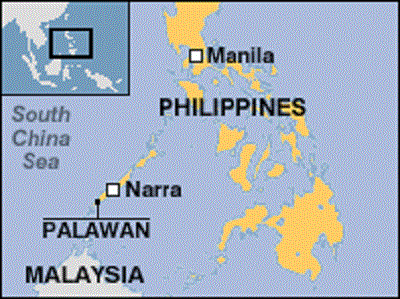5 Horrifying Pinoy Cannibals
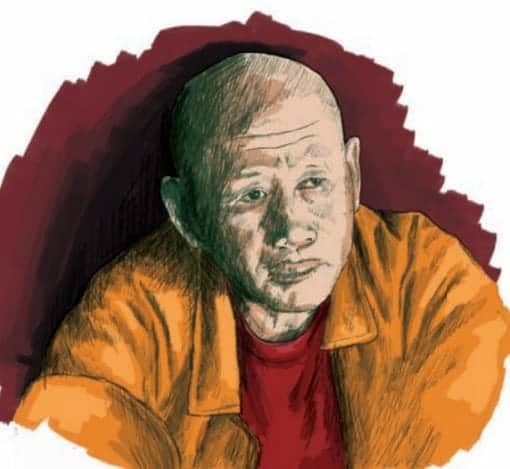
When it comes to food, Filipinos are so easy to please. Whether it’s a high-end filet mignon, a cheeseburger on the fly, or even the balut on the street, we Filipinos would eat them all.
However, like all civilized societies, we draw the line when it comes to cannibalism. It’s outdated, disgusting, and has no place in today’s world. Besides, no sane human being would even think about eating his fellow men, right?
The only problem is, not all people are sane, and from time to time we hear sickening news of people eating people around the world. Unfortunately, we also have our fair share here in the Philippines.
Also Read: The 10 Strangest Filipino Foods
Read on and find out about these Pinoy cannibals (listed in no particular order, their crimes are all gruesome anyway) who must have somehow lost their minds when they subjected their victims to a fate worse than death.
Note: The recent story of a Pinay cannibal in Indonesia is a hoax. Read on and find out why.
1. Amil Brothers.
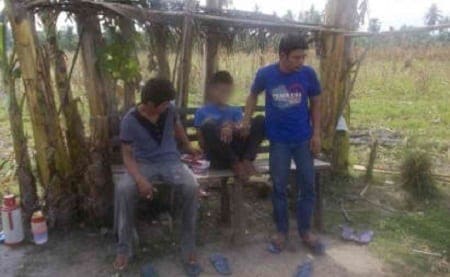
In probably one of the most gruesome modern cases of cannibalism in the Philippines, three brothers butchered their own mother to death in February 2014, after which they devoured her corpse.
According to authorities and witnesses, Dante, 35, Paroy, 21, and Ibrahim, 18, all Moros hailing from Ampatuan town in Maguindanao, hogtied and hacked their 56-year-old mother Musala to death and then feasted on her body “as if they were wild animals.”
When the body was recovered, several internal organs, the innards, and the eyes were missing. The brothers claimed afterward that they only tried to purge their mother of an evil spirit that was possessing her. Their neighbors, meanwhile, have said that the brothers may have been high on drugs when they committed the killing. Others, however, invoked an old tale that the brothers came from an accursed family of “ghouls.”
2. Raymundo Fonte.
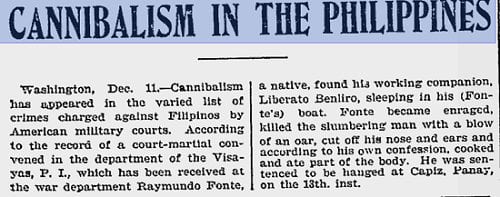
Although little is known of Raymundo Fonte’s history, it seems he was a tuba gatherer from Capiz (the folkloric haven of ‘aswangs’) who killed his co-worker Benliro Liberato with an oar after discovering the latter sleeping in his boat on Dec. 19, 1900.
The body of Liberato was later found floating in a stream, with his intestines, eyes, ears, and nose missing. Upon his capture and subsequent trial before a US military court, Fonte confessed to the killing and declared that he had eaten the missing body parts. He was hanged on Dec. 13, 1901.
3. Eladio Baule.
Weddings are supposed to be remembered as a joyous occasion. Instead, this particular one would be remembered solely because a wedding guest became part of the menu.
The macabre incident, which took place in the hinterland town of Narra, Palawan on July 17, 2004, started when the bride’s father Eladio Baule became angry after his cousin Benjie Ganay accidentally touched the bride’s bottom during the dance.
With the help of his son Gerald, nephew Sabtuari Pique and another cousin Junnie Buyot, Baule accosted Ganay and took him to a secluded area where they hacked him to death. They then roasted his body with kerosene and coconut leaves. After sampling their creation, they then brought the victim’s roasted remains back to the party and served it to the unwitting guests.
They would have gotten away with the crime too if Buyot hadn’t confessed to the police. He claimed that at the time of incident they were all drunk and had only been forced to kill and eat the body parts of their relative.
The shocking crime received international coverage due to its bizarre nature. Incidentally, Narra’s tourism suffered as a result of the townspeople being labeled as cannibals.
4. Efren Matedios.

A shocking case of cannibalism hit the sleepy town of Tabuelan, Cebu on May 23, 2011, when 29-year-old Efren Matedios disemboweled his 6-year-old niece and ate her internal organs.
Matedios, who was later arrested and charged for murder, claimed that he was innocent and stated he only did the act to prevent the child from becoming a ‘manananggal’. He denied he was a cult member or drug user.
His neighbors also said that weeks prior to the incident, Matedios had accidentally angered a reputed old witch in the area who cursed him to become an ‘ungo’ or flesh-eating monster in local folklore. They added that they were shocked at the incident since they knew that Matedios doted on his niece.
Also Read: 10 Lesser-Known Mythical Creatures in Philippine Folklore
According to police reports, he ran amuck after his niece’s mother refused to let her sleep beside him. Although the mother escaped his rampage, the little girl could not. When police found the girl’s body, they discovered that her internal organs had been placed on a plate and drizzled with salt.
5. Norberto Manero Jr.

Of course, a list of Filipino cannibals wouldn’t be complete without the most famous of them all in it. Known as Kumander Bukay to his supporters and enemies, Manero led the dreaded Christian vigilante group Ilaga against Muslim and communist rebels during the 1970s and 80s.
In the course of their campaigns, the group became notorious due to their penchant for mutilating the bodies of their victims and turning those body parts into amulets. Allegedly, they also ate some of the body parts.
It was Manero however, who would achieve the biggest notoriety after he was found guilty of masterminding the shooting of the Italian priest Tullio Favali on April 11, 1985, in Tulunan, Cotabato after they suspected him to be a communist. According to witnesses, a triumphant Manero taunted the fallen priest by scattering his brain and later eating parts of it.
Although he would be convicted and languish in prison for two decades, he finally walked out a free man in 2008. He has since lived a quiet life taking care of fighting cocks formerly owned by Manny Pacquiao.
Bonus Trivia: Rare ritual burial may reveal cannibalistic ancestry.
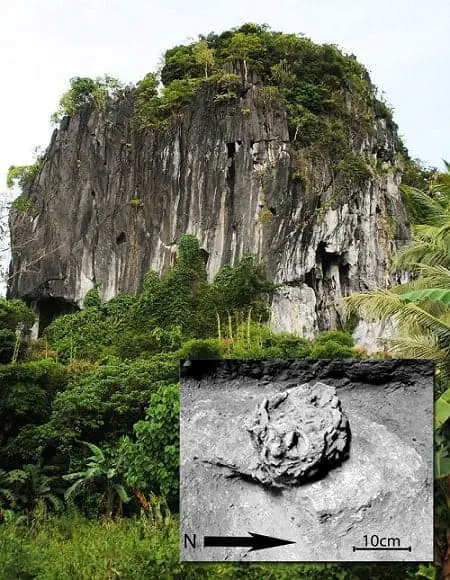
While we know that headhunting used to be prevalent among indigenous tribes in the country, there exists only scants reports of cannibalism, unlike those in other Pacific islands such as Polynesia and New Guinea.
However, the discovery of the remains of a 9,000-year-old woman in Palawan may yet shed light if our ancestors really practiced cannibalism.
Also Read: 15 Most Intense Archaeological Discoveries in Philippine History
According to scientists who made the find, the woman had her flesh and skin meticulously removed before being interred. Although for now, they think that this might have been purely for ritualistic purposes, they are not also ruling out cannibalism, noting that other tribes such as those in South America also practice eating their dead relatives.
Accordingly, the presence of bite marks on the bones would confirm just that.
References
BBC News, (2004). Philippines wedding guest ‘eaten’. [online] Available at: http://goo.gl/xIRlwr [Accessed 1 Sep. 2014].
Booc, R. (2011). Suspect claims: “Bad spirit” behind gruesome killing. [online] philSTAR.com. Available at: http://goo.gl/QgRqx1 [Accessed 1 Sep. 2014].
Clarke, P., Briggs, T. and Briggs, K. (2011). Extreme Evil: Taking Crime to the Next Level. 1st ed. Canary Press eBooks.
Espejo, E. (2014). Kumander Bucay: Living the ghost of his past. [online] Asian Correspondent. Available at: http://goo.gl/ZjhB8u [Accessed 1 Sep. 2014].
Luces, K. (2013). Ancient human remains in Palawan reveal rare ritual burial. [online] GMA News Online. Available at: http://goo.gl/uC8XNE [Accessed 1 Sep. 2014].
The Deseret News, (1901). Cannibalism in the Philippines. [online] p.1. Available at: http://goo.gl/JFRNg4 [Accessed 1 Sep. 2014].
Unson, J. (2014). Raps filed vs. siblings who killed, ate own mother. [online] philSTAR.com. Available at: http://goo.gl/8202Xc [Accessed 1 Sep. 2014].
FilipiKnow
FilipiKnow strives to ensure each article published on this website is as accurate and reliable as possible. We invite you, our reader, to take part in our mission to provide free, high-quality information for every Juan. If you think this article needs improvement, or if you have suggestions on how we can better achieve our goals, let us know by sending a message to admin at filipiknow dot net
Copyright Notice
All materials contained on this site are protected by the Republic of the Philippines copyright law and may not be reproduced, distributed, transmitted, displayed, published, or broadcast without the prior written permission of filipiknow.net or in the case of third party materials, the owner of that content. You may not alter or remove any trademark, copyright, or other notice from copies of the content. Be warned that we have already reported and helped terminate several websites and YouTube channels for blatantly stealing our content. If you wish to use filipiknow.net content for commercial purposes, such as for content syndication, etc., please contact us at legal(at)filipiknow(dot)net
